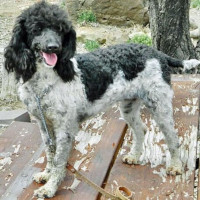Appearance of the Gordondoodle
|
| Since the Poodle and Gordon Setter differ so dramatically in appearance, it's not surprising that the Gordondoodle is not yet uniform in appearance. Some individuals will be tall and bulky like their Setter Gordon parent, others will be shorter and of a lighter, more elegant build like the Poodle. As with other hybrid dogs, it will take several generations of Gordondoodles before their appearance is standardized. Most will have a muscular body with long limbs and are a relatively large dog. Their face and muzzle are long and square, and their lips may or may not show a degree of playfulness. Their eyes will be almond-shaped and dark brown, giving them a pensive, calm expression. They have long ears that are often covered with wavy fur and hang behind their chin. Their chest is deep and they should have a visible abdominal fold. Their tail is long and fairly straight, sometimes held aloft during exercise or when excited. The Gordondoodle's mantle can be medium or long, and usually lies somewhere in the middle between wavy and curly. Feathering on the hind legs and tail is possible. While the Gordon Setter is never just black and brown, the Poodle can be composed of several colors, including apricot, white, gray, red, black and cream, and the Gordondoodle can take on one after another of the parents' colors. White spots are not uncommon. |
Temperament of the Gordondoodle
|
| Gordondoodles have an attractive personality, but need an experienced owner to bring out the best in them. They maintain close ties with their family and can become over-dependent, especially if they don't receive enough physical and mental stimulation in their daily lives. Assertive and affectionate with its family, the Gordondoodle is a well-balanced, calm companion. Thorough socialization is necessary for Gordondoodles to accept other animals in the home, and it's not always possible for them to coexist with other dogs. Ideally, Gordondoodles should be introduced to all other animals when they are puppies, as this will increase their chances of getting along well. Gordondoodles are very good watchdogs and like to bark to warn of intruders. To prevent them from becoming wary and aloof around family friends, these dogs need to be exposed to all kinds of people from an early age. Playful and sometimes cheeky, Gordondoodles welcome the chance to take part in any game or sport, and enjoy spending time outdoors and in nature. If they stay at home too long, they can start to feel cooped up and may begin to misbehave and develop harmful behaviors. |
Needs and activities of the Gordondoodle
|
| It would be unwise to underestimate the exercise needs of this boisterous breed, and owners will need to provide them with at least an hour and a half of activity a day. Gordondoodles love to swim and hike. They enjoy being taken on different trails and can get bored of the same scenery every day. They need lots of space and would ideally have a back garden where they could run around without leaving tracks. |
Maintenance of the Gordondoodle
|
| Although the Poodle is classified as hypoallergenic, when crossed this trait is not always inherited and some Gordondoodles will shed a reasonable amount of hair. Their coat is dense and will require good brushing several times a week, concentrating on the feathers to avoid tangles. The Gordondoodle's pendulous, hairy ears create an ideal environment for the development of bacteria and yeast. So you need to keep them clean and dry at all times. A veterinary ear cleaner should be used two or three times a month for ears prone to waxing. |









 English (United Kingdom)
English (United Kingdom)